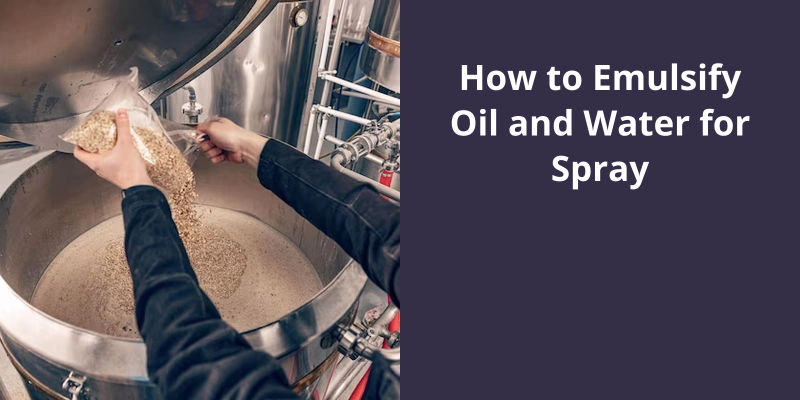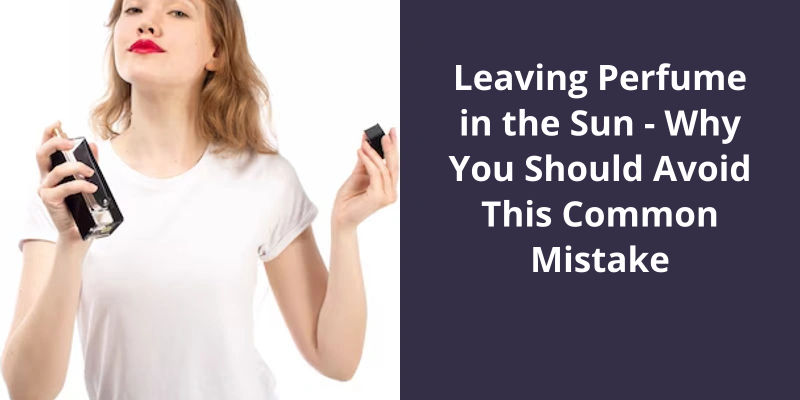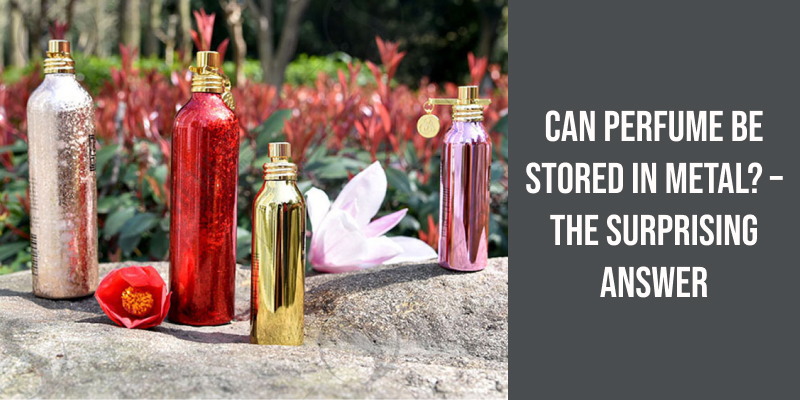To emulsify oil and water for a spray, you’ll need an emulsifier, which is a substance that can mix oil and water without them separating. Select one like lecithin, which is natural and you can find it in foods like eggs. First, heat your water but don’t boil it. Then, add the oil slowly while rapidly mixing it with a blender. Once you see the two combined and start looking milky, begin to add your emulsifier slowly. Keep mixing it until you see a consistent mixture. Once you’re done, let it cool down before putting it in your spray bottle. It’s essential to keep shaking your spray before each use because oil and water can still separate over time. Emulsifying isn’t permanent, but you may have a nicely mixed spray for a short or moderate span of time depending on the emulsifier you used.

How Do You Emulsify Oil and Water in Cooking?
One common method for emulsifying oil and water in cooking is to use an emulsifying agent, such as egg yolks or mustard. These substances contain molecules that are both hydrophilic and hydrophobic, meaning they can interact with both water and oil. By vigorously mixing the emulsifier with the water and fat/oil, the molecules can disperse evenly throughout the mixture, creating a stable emulsion.
Another important factor in creating a stable emulsion is the temperature of the ingredients. If the water and oil are too cold, they’ll not mix well with the emulsifier, and the emulsion may break. On the other hand, if the temperature is too high, the emulsifying agent may become denatured, losing it’s ability to create a stable mixture. It’s important to follow the recipe instructions carefully and to use a thermometer to ensure the proper temperature range.
The emulsifier should be added slowly and continuously mixed into the water and oil until a smooth, uniform mixture is achieved. This may require a whisk, blender, or other mixing tool, depending on the recipe and the ingredients used.
One popular application of emulsions in cooking is in the creation of sauces and dressings. For example, mayonnaise is made by emulsifying egg yolks, oil, and vinegar or lemon juice. The resulting emulsion is thick and creamy, providing a rich flavor and texture to dishes. Similarly, vinaigrettes and other salad dressings are typically made by emulsifying oil and vinegar or citrus juice with an emulsifying agent.
Overall, emulsification is an important technique in cooking, allowing chefs and home cooks to create a wide range of delicious and visually appealing dishes. By understanding the science behind emulsification and using quality ingredients and proper techniques, it’s possible to create stable, flavorful emulsions in the kitchen.
Now that we know how to prevent oil and water from separating using emulsifiers, it’s useful to understand how exactly these substances work.
How Do You Keep Oil and Water From Separating?
Emulsifiers are amphiphilic molecules, which means they’ve a hydrophilic (water-loving) head and a hydrophobic (fat/oil-loving) tail. These molecules arrange themselves at the interface between water and oil, with their heads facing the water and their tails facing the oil. This creates a stable layer that prevents the oil droplets from coalescing and separating from the water.
Another way to prevent oil and water from separating is through the use of mechanical agitation. This involves mixing the two substances together vigorously to create an emulsion that remains stable for a certain amount of time. However, this method isn’t as reliable as using emulsifiers, especially for long-term storage or when dealing with larger quantities of liquids.
One common example of an emulsifier is lecithin, which is found in egg yolks and soybeans. It’s often used in food products such as mayonnaise and salad dressings to prevent oil and vinegar from separating. Other emulsifiers include mono- and diglycerides, polysorbate 60, and carrageenan.
It’s important to note that not all emulsions are stable and over time the oil and water may still separate due to factors such as temperature changes or pH shifts. In some cases, additional emulsifiers may need to be added or the formulation may need to be adjusted to achieve a more stable emulsion.
Different Types of Emulsifiers and Their Properties
Emulsifiers are substances that help to mix two immiscible liquids, such as oil and water. There are several types of emulsifiers with different properties, including natural, synthetic, and semi-synthetic emulsifiers. Some emulsifiers are oil-soluble, while others are water-soluble. Additionally, emulsifiers vary in their surface activity, meaning how well they can adsorb onto the surface of oil droplets in water. Emulsifiers also have different emulsifying properties, depending on the type of emulsion desired, such as oil-in-water or water-in-oil emulsion.
Understanding how oil and water interact is important in many industries, from food production to cosmetics. Emulsification is the process of mixing oil and water to form a stable, homogeneous mixture. While it may seem like a simple task to shake oil and water together, there’s actually a lot of chemistry at play in creating a stable emulsion. In this article, we’ll explore the science behind emulsification and some common techniques for forming emulsions.
How Do You Emulsify Oil and Water?
This mixture is called an emulsion. Emulsions can be made from many substances including oils and fats. The key to forming an emulsion is in creating a stable mixture where the oil and water stay combined. This is achieved by using an emulsifying agent which acts as a stabilizer.
Emulsifying agents are compounds that help to mix oil and water by reducing the surface tension between the two substances. These agents work by coating the oil droplets with a layer that’s attracted to water. This prevents the oil droplets from coalescing and separating from the water. Examples of emulsifying agents include egg yolks, mustard, and lecithin.
Next, you need to add the emulsifying agent to the mixture. This helps to distribute the agent evenly throughout the mixture and ensures that it’s well incorporated.
Once the emulsifying agent has been added, the mixture can be blended together using an immersion blender or a whisk. This helps to break up any larger oil droplets and create a smooth, uniform mixture. The resulting emulsion should be creamy and well mixed, with no visible separation between the oil and water.
One factor that can affect the stability of an emulsion is the temperature. Most emulsions are stable at room temperature, but can separate if exposed to heat or cold. For example, mayonnaise will often break if it’s stored in the fridge for too long. To minimize this problem, it’s important to store emulsions in a cool, dry place and to avoid sudden changes in temperature.
By understanding the properties of different emulsifying agents and using the right techniques, it’s possible to create a wide range of emulsions, from basic salad dressings to complex sauces and creams. With practice and experimentation, you can learn to master the art of emulsifying and create delicious recipes that are sure to impress your friends and family.
Now that we understand the basics of emulsion and the suggested use of emulsifier with essential oils and water, let’s delve into the step-by-step process of emulsifying essential oils and water. This method is an excellent way to create a well-blended mixture of your desired essential oils and water, unlocking their beneficial properties.
How Do You Emulsify Essential Oils and Water?
Emulsion is an essential aspect of many industries, from cosmetics to pharmaceuticals, and the process of emulsification can be complex. Emulsifiers are molecules that can help mix two substances that wouldn’t otherwise blend, such as oil and water. An essential oil emulsion is a mixture of essential oils and water that have been emulsified using an emulsifier.
However, essential oils aren’t water-soluble, so they require an emulsion to be mixed with water and enable their properties to be absorbed by the body.
This enables it to form a stable link between the oil and water phases of the mixture, preventing the oil from separating out and floating on top of the liquid. One of the most commonly used emulsifiers is Polysorbate 20, which is known for it’s ability to mix oil and water.
In general, a 1:1 ratio of emulsifier to essential oil is required, but this can vary depending on the particular emulsifier being used. Once the emulsifier and essential oil are mixed, it’s important to add the water slowly, stirring continuously to ensure that the mixture emulsifies correctly. Once the emulsion is complete, it can be stored in a dark, cool place for future use.
The use of an emulsifier, the right amount of emulsifier and water, and correct agitation are key to achieve a stable and effective emulsion.
Source: Essential Oil Emulsifier, 15 ml – Abundant Health
In conclusion, stabilizing water-in-oil emulsions can be achieved through the use of colloidal particles that have undergone surface modification with short amphiphilic molecules. The resulting partial hydrophobicity of the particles allows for their efficient adsorption at the oil-water interface, thus providing a stable emulsion. But what other methods can be employed to stabilize emulsions? Let’s explore some of these techniques in more detail.
How Do You Stabilize Water in Oil Emulsion?
This led to the formation of a strong and stable interfacial layer that prevented the emulsion droplets from coalescing and separating. The use of colloidal particles as stabilizers also provided several advantages over traditional emulsifiers, including enhanced stability over a broad range of pH and ionic strength, as well as improved control over the emulsion droplet size.
The selection of the appropriate stabilizer particles and amphiphilic molecules is critical to achieving stable emulsions. In addition, the choice of the oil and water phases, as well as the emulsification method, can also affect the stability of the emulsion.
Techniques for Emulsion Stabilization: The Article Can Explore Some Common Techniques Used to Stabilize Water in Oil Emulsions Such as Homogenization, Sonication, Microfluidic and Nanoemulsion Techniques.
The article discusses various methods employed for stabilizing water in oil emulsions. It covers techniques such as homogenization, sonication, microfluidic and nanoemulsion techniques.
Now that we know about the properties of oil in water emulsion systems, let’s dive into the different types of emulsifying agents that are used to stabilize these systems and prevent them from separating. These emulsifying agents play a crucial role in maintaining the stability of the emulsions and ensuring that they’re safe for consumption. In this article, we will explore some of the most commonly used emulsifying agents, their properties, and their applications in the food industry.
What Are the Emulsifying Agents Used to Stabilize the Emulsion of Oil in Water?
Emulsions are mixtures that consist of two immiscible liquids like oil and water. They’re essential in the food industry because they’re used for the production of a variety of products like salad dressings, mayonnaise, and spreads. Emulsifying agents are used as stabilizers to ensure that the oil droplets in the emulsion don’t merge. The stability of an oil in water emulsion depends on the electrical charges present on the surface of the droplets.
Lecithin is a widely used emulsifying agent in the food industry. It’s a naturally occurring phospholipid that’s both hydrophobic and hydrophilic properties. Lecithin reduces the surface tension between oil and water, which enables them to form a stable emulsion. Another commonly used emulsifying agent is gum arabic. It’s a natural polysaccharide that’s extracted from the sap of acacia trees. It’s used for it’s high molecular weight, which enables it to have a high capacity for water and oil binding.
Octenyl succinate starches are another class of emulsifying agents that are used to stabilize oil in water emulsions. They’re modified food starches that exhibit both lipophilic and hydrophilic properties. They bind to the oil droplets, forming a protective layer around them, which prevents them from coalescing. This protective layer is formed due to the negative charges that the octenyl succinate starches carry on their surface.
The stability of an oil in water emulsion is also affected by the pH of the system. Most emulsifying agents are effective at a pH between 4.5 and 8.0. At pH values outside this range, the emulsion may break. Emulsions can also be destabilized by the presence of salt ions or heat. High salt concentrations can cause the droplets to coalesce, while heat can cause the emulsifying agents to denature, thereby weakening the protective layer around the droplets.
Overall, emulsifying agents are essential in the production of oil in water emulsions. They help to stabilize the emulsion, prevent the droplets from merging, and ensure that the emulsion remains stable during processing and storage. Lecithin, gum arabic, and octenyl succinate starches are just a few examples of the many emulsifying agents that are used in the food industry. It’s important to select the right emulsifying agent for a particular application to ensure the stability and quality of the final product.
Comparison of Different Emulsifying Agents in Terms of Their Effectiveness, Availability, and Cost.
- Soy lecithin
- Egg yolk
- Mustard
- Mayonnaise
- Monoglycerides
- Diglycerides
- Polysorbate 80
- Carrageenan
Conclusion
In conclusion, emulsifying oil and water for spray can be achieved by using an emulsifier that helps mix the two together. It’s recommended to start with a small amount of emulsifier and gradually increase until the desired consistency is achieved.





